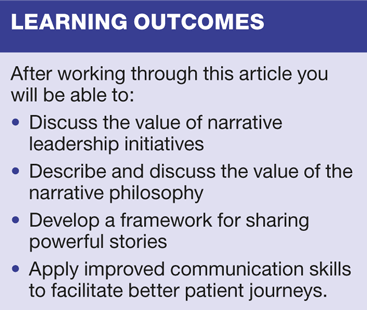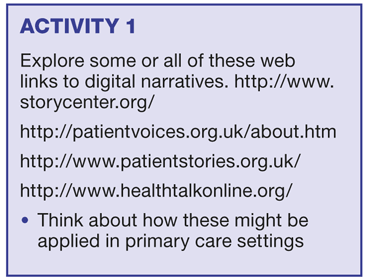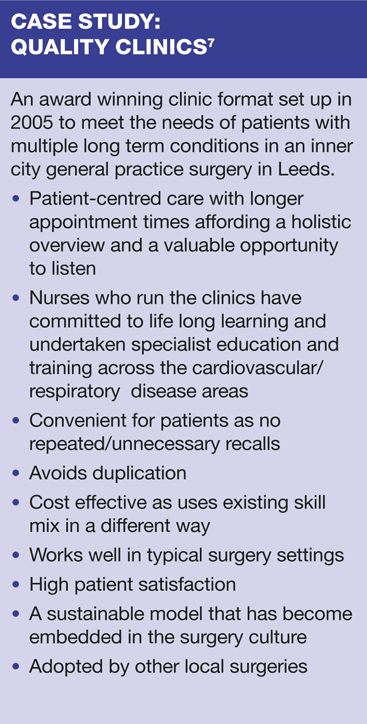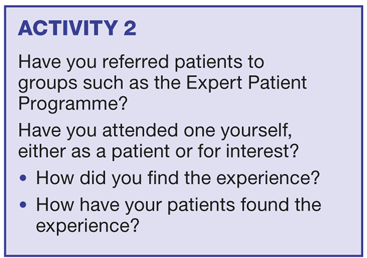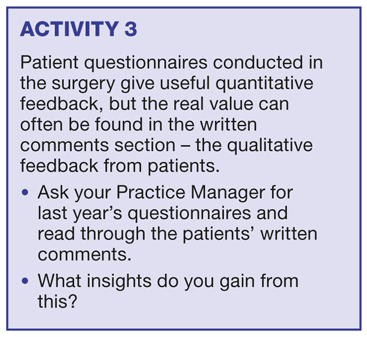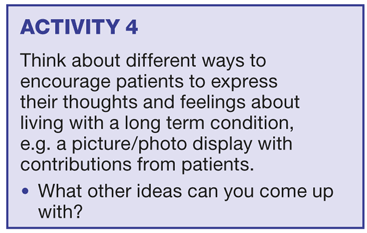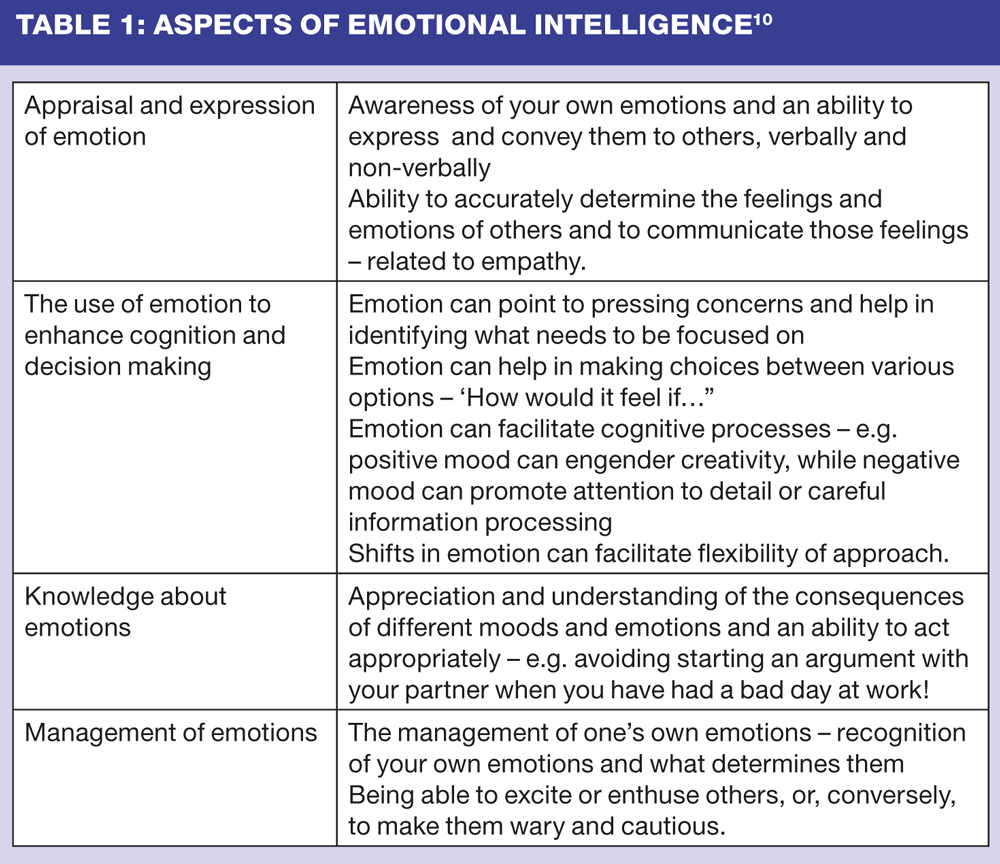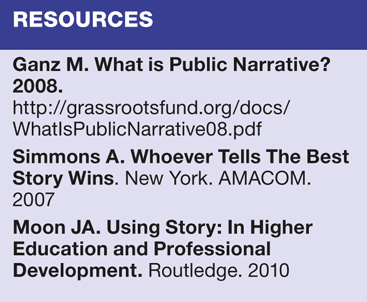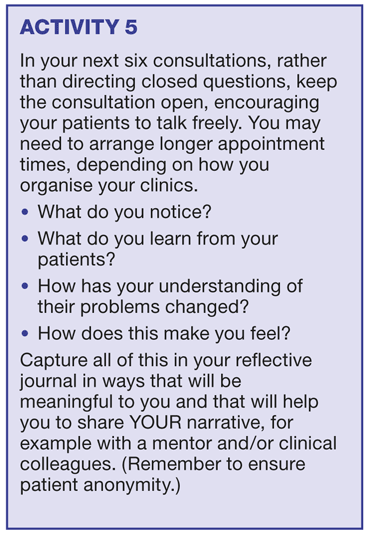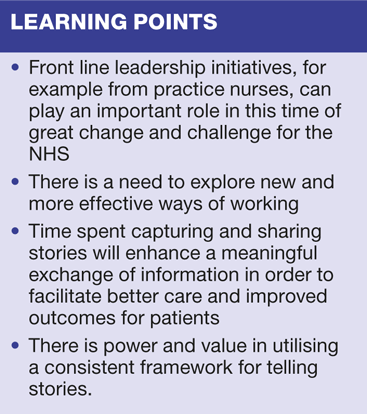Narrative leadership: Using patient stories to shape better services
Rhian Last RGN MAMS PGC (Leadership) UCPPD PGC (Primary Care Education)
Rhian Last RGN MAMS PGC (Leadership) UCPPD PGC (Primary Care Education)
Clinical Lead, Education For Health, Warwick
Clinical Lecturer in Primary Care Education, AUPC, University of Leeds
In today's NHS clinical leadership at the front line is needed to improve services. Narrative leadership is one way practice nurses can contribute to the improvement agenda.
The Health and Social Care Act 2012 heralds sweeping changes for the future organisation of the National Health Service. The need for clinical leadership to improve the quality of patient care has been identified, but as yet there has been no articulation of how this might be played out at the front line. Yet it is where we meet and interact with our patients, face to face, that we will best discover what we are doing well, and what we might improve. Those of us that work at the forefront of primary care therefore need to consider what leadership strategy we might usefully appropriate in order to achieve improved patient care.
One strategy that we might employ is narrative leadership - the willingness to hear and learn from the stories people tell us then, deliberately and co-operatively, use those stories to implement change for the better. The value of narrative leadership and the power of sharing stories at the front line of healthcare is considered here.
BACKGROUND
'Everything that can be counted does not necessarily count; everything that counts cannot necessarily be counted.' Albert Einstein
Since the introduction of the Quality and Outcomes Framework (QOF) in 2004 we have seen a steady rise in the number of people with long term conditions being screened and monitored in primary care and, in many areas, practice nurses take a major role in the care of these individuals. Many aspects of patient care have been 'counted' in order to achieve QOF targets and the statistics gleaned from QOF have provided us with some useful data. However, one could argue that not all of the things that have been counted for QOF actually contribute to improved care and outcomes. There are some significant statistics emerging from wider research that we cannot choose to ignore.
Prescribing and adherence
In relation to prescribing and medication adherence, it has been found that:
- One third of patients prescribed statins do not take them1
- Some patients do not take their prescriptions to the pharmacy to be filled.2
If we are to improve outcomes and make best use of scarce and costly resources we need to better identify patients who do not adhere to their prescribed medication regime, or who self medicate or hoard their tablets. We also need to gain an insight into the implications for patients of polypharmacy.3
Recent research indicates that, for NHS primary and community care prescriptions in England, the gross annual cost of medicines wastage is currently in the region of £300 million per year.4 It is estimated that half the cost of this wastage could be avoided. It is also estimated that up to £500 million of extra value could be generated in the five therapeutic areas of asthma, diabetes, hyperetension, vascular disease and schizophrenia if medicines were used in the optimal manner. In many practices patient management in these therapeutic areas is within the remit of the practice nurse. In our cash-strapped NHS we all need to ensure best value for medication use.
Shaping services to patient need
We need to fully consider what we as clinicians can do better for our patients and how our services might facilitate improved patient outcomes. We need to bear in mind that 'We are not hosts in our organisations so much as we are guests in our patients' lives.'5 We should be looking to shape services around patient needs rather than practice convenience. Current models for patient review may well be too focused on QOF determinants and be missing vital pieces of information pertinent to the individual patient and their story. Failure to hear and act on such information may ultimately lead to patients being given conflicting or inappropriate advice and information, resulting in misunderstandings and poor adherence, increased costs to the NHS and poorer patient outcomes.
Patients are often called to disease-specific clinics. This model may prove both unsustainable and unsuitable for a growing population with multiple co-morbidities.6 These individuals may have to make frequent, possibly inconvenient or difficult visits to the surgery and may see different clinicians for each of their conditions. Organising longer clinic appointments for patients with multiple long term conditions is both feasible, achievable and sustainable.7 (Box 1) This challenges the current review process in many general practice surgeries, but does provide a golden opportunity to improve the service that we currently offer. For example, longer appointment times would afford greater opportunity to capture and listen to the patient narrative in order to really understand life with long term conditions from their point of view. Such understanding will help shape patient management so that it is relevant and appropriate to the individual, which may in turn result in improved self-management and medication usage.
WHO CAN MAKE CHANGE HAPPEN?
Change requires leadership, which can operate at all levels but leadership requires both competence and capability.8
The most effective leaders score high in emotional intelligence.9 This can be broken down into four main aspects (Table 1)10 and includes the characteristics of self awareness, self regulation, motivation and social skill. Emotion is an important factor in decision-making. We need to be able to understand ourselves and understand others. While such skills can be taught, they tend to come with experience and maturity.
Who then might be responsible for leading the way? This is an opportunity for leadership to emerge from front line nurses. Practice nurses are fundamental to the care of patients with long term conditions in primary care.11 Their duty of care to their patients should be a driver for them to identify what might be done better and to motivate both themselves and others to drive for change and improvement. A perfect mantra might be taken from Hillel the Elder, namely: 'If not me, then who?'
NARRATIVE LEADERSHIP
Narrative leadership involves harnessing the power of story and narrative to improve communication. This can bring about change, both to the person and the organisation.12
Narrative can take different forms:
- Oral - the sharing of stories either in one to one consultation or in groups, e.g. groups within the Practice or wider groups such as the Expert Patient Programme (available at http://www.expertpatients.co.uk/)
- Visual - drawing out information utilising pictures and /or photographs. This has been usefully implemented for children with asthma13 and wider groups of young people14
- Written - e.g. free text feedback in patient questionnaires
- Digital - utilising the ever-expanding facilities of information technology.
Narrative based medicine
Narrative based medicine gives patients permission, and time, to tell us what receiving a diagnosis and living with a long term condition is like for them. Indeed, there is an imperative for people to be allowed to articulate their story if we are truly to deliver patient centred care.15 As clinicians, we often fail to truly listen to what a patient has to tell us, and, as a consequence, the advice we give can be both irrelevant and meaningless and directed at a totally different story.16 What we need to develop is narrative competence: the skill of absorbing, interpreting and responding to stories.17
While it is important to listen to what people say, it is equally important to remember the hidden narratives conveyed by body language, appearance and other clues (e.g. evidence of smoking and alcohol from odour) which might contradict what an individual is saying (e.g. I don't smoke/drink).
Shared reflection, which can result in improved self confidence and a better ability to challenge,18 brings us to the next stage of narrative leadership: changing the culture of the organisation.19 Sharing the understanding you have gained from listening to your patient's narrative in this new way of consulting can serve to enthuse and inspire your clinical colleagues to consider the idea of a change in practice.
It's important that your message is not perceived as focusing on you and your perceptions, but rather that you draw everyone into your story and make it meaningful to them.20 If you make an effort to involve wider members of the clinical team, tapping into their energy, you are more likely to evoke a positive reaction.21 When shaping your narrative encourage a wider sharing of ideas within the group and also harness the power of 'emotional contagion', where feelings and reactions are spread from one person to another, or to a wider group.22 A simple example of emotional contagion is the baby who smiles back at someone who smiles at him. An open, positive body language and facial expression while you share your story can be picked up and spread around the group. An effective team flourishes when there is a common purpose and shared objectives so it is important to take a collaborative approach.23
FORMAT FOR SUCCESSFUL STORYTELLING
Every good story needs a plot that resonates with listeners and captures their attention. It needs a character that they can identify with. The story should develop to present a challenge and offer the choice of an outcome; one that offers hope rather than fear. Fear can paralyze whereas hope can motivate action. Finally there should be a moral compass and a call to action that stirs the listeners and spurs them on. A format which engages people in an emotional dialogue and draws on their values has been proposed by Marshall Ganz, a 'guru' of narrative leadership.24
A narrative, according to Ganz, consists of the following four elements:
1. The Story of Self
This is where you tell your story, identifying a common cause that resonates with the values shared by you and your team members. Candour and honesty will add to conviction.25 You can share the powerful notes from your reflective journal and what the patient narratives brought to you.
2. The Story of Us
Develop your story of self to become a story of us. Draw the group together by comparing this story to other stories from within the community, which the team will recognize and identify with, e.g. previous patient stories, or the learning outcomes of an adverse event. This threads your story of self into the community identity and bonds you together.
3. The Story of Now
Identify the challenge you all face. For example, you might inform the group of emerging issues regarding patient compliance which are not being addressed in the way consultations are currently being conducted. While it is important to create a sense of urgency, infusing the wrong emotion can cause inertia and lack of motivation. Enthusiasm can be inspired by articulating a credible vision of hopefulness.
4. Call To Action
Building on this momentum will turn challenge into hope and set the direction for a new beginning and a communal call to action.
Does this model work? One call to action that you will be familiar with is Barack Obama's pre-election mantra, 'Yes, we can!' - written by Marshall Ganz, powerfully delivered by the now President Barack Obama, and so effectively constructed around the model described here.
CONCLUSION
The NHS is undergoing a paradigm shift in the commissioning of services and the organisation of care at a time of huge financial challenge. The rapidly escalating number of people with multiple morbidities creates an imperative for good nurse leadership at the front line of general practice. Narrative leadership skills can help create environments of trust and openness, inspiring and driving new and better directions for improvement. More time spent listening, sharing and learning will lead to better patient engagement, will avoid unnecessary hospital admissions, improve patient outcomes and quality of life and reduce waste.
REFERENCES
1. British Heart Foundation. The Press Association. Third of heart risk patients not using cholesterol drugs. Available at http://www.nursingtimes.net/nursing-practice/clinical-specialisms/cardiology/third-of-heart-risk-patients-not-using-cholesterol-drugs-bhf/5045037.article
2. Jones I, Britten N. Why do some patients not cash their prescriptions? Br J Gen Pract. 1998;48:903-905.
3. Murphy J, Coster G. Issues in Patient Compliance. Drugs 1997; 54(6):797-800
4. University of York. Evaluation of the Scale, Causes and Costs of Waste Medicines: Final Report
http://php.york.ac.uk/inst/yhec/web/news/documents/Evaluation_of_NHS_Medicines_Waste_Nov_2010.pdf
5. Berwick DM. "Escape Fire: Lessons for the Future of Health Care" Commonwealth Fund. 2002. p. 54
6. Barnett K, Mercer SW, Norbury M et al. Epidemiology of multimorbidity and implications for health care, research, and medical education: a cross-sectional study The Lancet 2012; 10 May 2012 DOI: 10.1016/S0140-6736(12)60240-2
7. Robertson A, Leaman B. Leading and implementing change in primary care. Practice Nurse 2007; 33(3): 18
8. Fraser S, Greenhalgh T. Coping with complexity: educating for capability. BMJ 2001; 323: 799-803.
9. Goleman D. Working with emotional intelligence. New York. Bantam Books. 1988
10. George J. Emotions and leadership: the role of emotional intelligence. Human Relations 2000; 53: 1027-55 Available at:
http://hum.sagepub.com/cgi/content/abstract/53/8/1027 (Accessed June 2012)
11. Charles-Jones H, Latimer J, May C. Transforming general practice: the redistribution of medica work in primary care. Sociology of Health and Illness 2003; 25(1): 71-92.
12. Cass Business School. Narrative Leadership: How to use the power of story for organisational and personal change. City of London. Cass Business School. 2008http://bunhill.city.ac.uk/media/events.nsf/(httpCllcPastEvents)/C17C29E99B31C8DD8025731600
13. Rich M, Chalfen R. Showing and telling asthma: Children teaching physicians with visual narrative. Visual Sociology 1999; 14(1):
14. Sarah E. Drew SE, Duncan RE, Sawyer SM. Visual Storytelling: A Beneficial But Challenging Method for Health Research With Young People. Qual Health Res 2010; 20: 1677 Available at http://qhr.sagepub.com/content/20/12/1677
15. Strauss AL. Chronic Illness and the Quality of Life. St Louis. Mosby. 1975
16. Greenhalgh T, Hurwitz B. Why study narrative? BMJ 1999; 318: 48-50
17. Charon R. Narrative Medicine: A Model for Empathy, Reflection, Profession, and Trust. JAMA. 2001;286(15):1897-1902 Available at http://acmd615.pbworks.com/f/Narrative3.pdf
18. Platzer H, Blake D, Ashford D. An evaluation of process and outcomes from learning through reflective practice groups on a post-registration nursing course. Journal of Advanced Nursing 2000; 31: 689-695. doi: 10.1046/j.1365-2648.2000.01337.x
19. Denning S. The Secret Language of Leadership: How Leaders Inspire Action Through leadership. Jossey-Bass. Wiley. 2007
20 Greenleaf R. Servant Leadership. New York. Paulist Press. 1991
21. Lewis S, Passmore J, Cantore S. Appreciative inquiry for change management: Using AI to facilitate organizational development. London: Kogan Page. 2007
22. Barsade SG. The Ripple Effect: Emotional Contagion and Its Influence on Group Behavior. Administrative Science Quarterly 2002; 47(4): 644-675 Available at http://www.jstor.org/discover/10.2307/3094912?uid=3738032&uid=2&uid=4&sid=21100840074231
23. Pearson P, Spencer J. Outcome measures for teamwork in primary care. In P. Pearson & J. Spencer (Eds.), Promoting teamwork in primary care: A research-based approach. London: Arnold. 1997
24. Ganz M. What is Public Narrative? Cambridge: Harvard Kennedy School of Government, 2008.
25. Bennis W. The Leadership Advantage. Leader to Leader. 1226.(Spring 1999): 18-23. Available at http://leadertoleader.org/leaderbooks/L2L/spring99/bennis.html
Related articles
View all Articles
